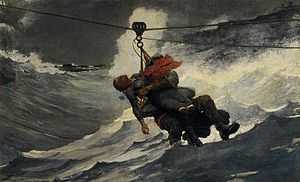Breeches buoy

A breeches buoy is a crude rope-based rescue device used to extract people from wrecked vessels, or to transfer people from one location to another in situations of danger. The device resembles a round emergency personal flotation device with a leg harness attached. It is similar to a zip line.The breeches buoy was usually deployed from either ship to ship, or ship to shore using a rocket, kite system,[1] or a lyle gun, and allowed single person evacuations. A line is attached to the ship, and the person being rescued is pulled to shore in the breeches buoy which rides the line similar to a zip line.

Competition
In Sea Scouts, use of a breeches buoy has become one of the events that are competed in at regattas such as the Old Salts' Regatta and the Ancient Mariner Sea Scout Regatta. The competition simulates an actual breeches buoy rescue situation.
Before the event the crew sets up their equipment, which includes a thin shot line attached to the tower simulating the crow's nest of a sinking ship, a high line made of a hawser, a block and tackle, a dead man with a cleat, an endless whip with a block, a chair, and shear legs. Once the equipment is prepared, two scouts go up to the tower (these scouts must wear harnesses for safety in most of today's competitions). The coxswain calls the four or five scouts remaining on the ground to attention.
No further talking is allowed by anyone except for the coxswain and the two participants in the tower. No communication other than yes and no arm signaling is allowed between the tower and ground. At the go signal, time begins and does not stop until the participant who is being rescued from the tower is on the ground and the coxswain calls the crew to attention again.
One member of the ground crew ties the whip block tail to the shot line. The coxswain signals the tower, and the tower returns the affirmative signal. The tower then hauls the whip up to them on the shot line, and ties the whip block tail to the mast with a round turn and two half hitches.[2] The tower signals to the coxswain who returns the signal. The ground crew attaches the high line through the chair to the endless whip and raises the high line to the tower. Once the high line reaches the tower, it is attached to the mast with a round turn and two half hitches and a signal is passed to the coxswain.
The ground crew ties a bowline on a bight into the high line and hooks it to the blocks. The crew hauls on the blocks tightening the high line and secures it to the deadman with a cleat hitch. The shear legs are put in place. The chair is attached to the endless whip and raised to the tower. When everything on the ground is set, the coxswain signals the tower. One member of the tower crew gets in the chair, clips in, and signals the ground crew. The rider must sit and is not allowed to "surf" the chair for added speed as popularized by Stefan Geiger. The rider must be stopped in a controlled manner and removed from the chair. Time stops when the ground crew is called to attention by the coxswain.
Judges are responsible for halting progress if they deem a situation unsafe, and for correcting the situation as well as assessing penalties for violations such as talking and crossing the water line.[3]
See also
References
- ↑ Life-Saving Apparatus, Albert F. Rockwell, US434725
- ↑ Personal experience of being a coastguard for thirty two years
- ↑ "The Ancient Mariner Sea Scout Regatta". Ancient Mariner. Retrieved 2011-10-07.